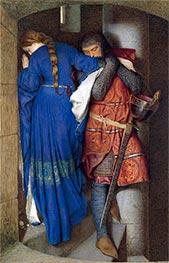
Frederick William Burton Giclée Fine Art Prints
1816-1900
Irish Pre-Raphaelite Painter
Frederick William Burton's journey from Irish painter to influential curator presents a fascinating narrative of artistic and institutional achievement in Victorian Britain. Born in County Wicklow in 1816, Burton showed remarkable artistic promise from an early age, leading to his election as an associate of the Royal Hibernian Academy when he was just twenty-one.
His early years in County Clare, where his family moved when he was six, profoundly influenced his artistic sensibilities. The Burton family's prestigious position - his grandfather served as High Sheriff of Clare - provided young Frederick with the cultural foundation that would later shape his career. His education in Dublin refined these early advantages, culminating in his creation of works that would become cornerstones of Irish art.
Burton's watercolor technique reached its apex in two celebrated works: "The Aran Fisherman's Drowned Child" (1841) and "The Meeting on the Turret Stairs" (1864). The latter's enduring impact on Irish cultural consciousness was confirmed when the public voted it Ireland's favorite painting in 2012, speaking to Burton's ability to capture profound emotional moments with technical precision.
His artistic development was enriched by extensive European travel, beginning with a transformative visit to Germany and Bavaria in 1842. These journeys provided Burton with deep insight into Old Master works, knowledge that would prove invaluable in his later curatorial role. His seven-year appointment as court painter to Maximilian II of Bavaria further expanded his artistic and cultural horizons.
Burton's appointment as director of the National Gallery, London, in 1874 marked a significant shift from creator to curator. Over his twenty-year tenure, he transformed the institution's collection through astute acquisitions, including Leonardo da Vinci's "Virgin of the Rocks" and Raphael's "Ansidei Madonna." His curatorial vision added more than 500 works to the gallery, fundamentally reshaping Britain's national collection.
Recognition of Burton's contributions came in multiple forms - knighthood in 1884, an honorary membership in the Royal Society of Painters in Watercolours, and an LL.D. from Dublin in 1889. His death in Kensington in 1900 marked the end of a career that bridged the worlds of artistic creation and institutional leadership, leaving an indelible mark on both Irish and British cultural heritage.
His early years in County Clare, where his family moved when he was six, profoundly influenced his artistic sensibilities. The Burton family's prestigious position - his grandfather served as High Sheriff of Clare - provided young Frederick with the cultural foundation that would later shape his career. His education in Dublin refined these early advantages, culminating in his creation of works that would become cornerstones of Irish art.
Burton's watercolor technique reached its apex in two celebrated works: "The Aran Fisherman's Drowned Child" (1841) and "The Meeting on the Turret Stairs" (1864). The latter's enduring impact on Irish cultural consciousness was confirmed when the public voted it Ireland's favorite painting in 2012, speaking to Burton's ability to capture profound emotional moments with technical precision.
His artistic development was enriched by extensive European travel, beginning with a transformative visit to Germany and Bavaria in 1842. These journeys provided Burton with deep insight into Old Master works, knowledge that would prove invaluable in his later curatorial role. His seven-year appointment as court painter to Maximilian II of Bavaria further expanded his artistic and cultural horizons.
Burton's appointment as director of the National Gallery, London, in 1874 marked a significant shift from creator to curator. Over his twenty-year tenure, he transformed the institution's collection through astute acquisitions, including Leonardo da Vinci's "Virgin of the Rocks" and Raphael's "Ansidei Madonna." His curatorial vision added more than 500 works to the gallery, fundamentally reshaping Britain's national collection.
Recognition of Burton's contributions came in multiple forms - knighthood in 1884, an honorary membership in the Royal Society of Painters in Watercolours, and an LL.D. from Dublin in 1889. His death in Kensington in 1900 marked the end of a career that bridged the worlds of artistic creation and institutional leadership, leaving an indelible mark on both Irish and British cultural heritage.
2 Frederick Burton Artworks

Giclée Canvas Print
$61.68
$61.68
SKU: 3111-FWB
Frederick William Burton
Original Size:95.5 x 60.8 cm
National Gallery, Dublin, Ireland
Frederick William Burton
Original Size:95.5 x 60.8 cm
National Gallery, Dublin, Ireland

Giclée Canvas Print
$61.68
$61.68
SKU: 6571-FWB
Frederick William Burton
Original Size:20.3 x 30.5 cm
Yale Center for British Art, Connecticut, USA
Frederick William Burton
Original Size:20.3 x 30.5 cm
Yale Center for British Art, Connecticut, USA